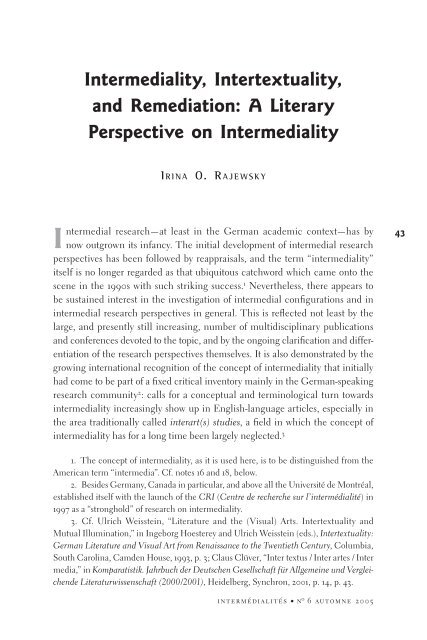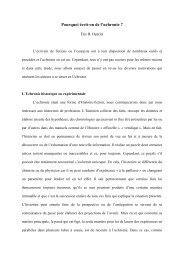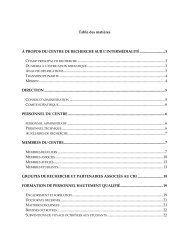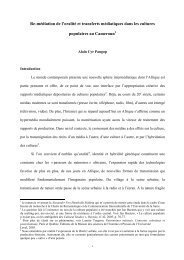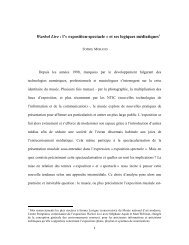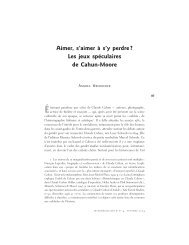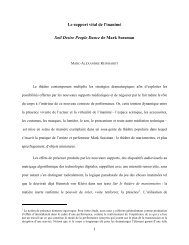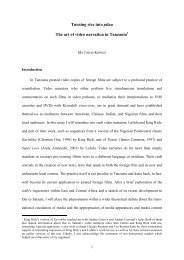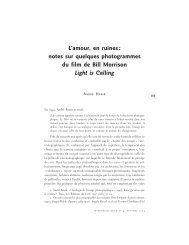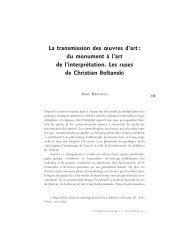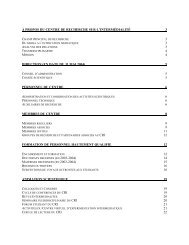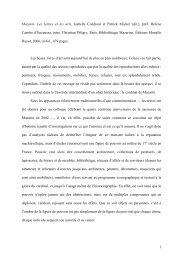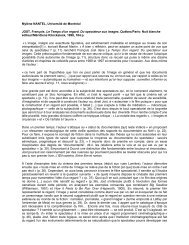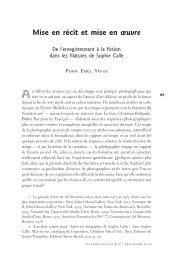Intermediality - Centre de recherche sur l'intermédialité (CRI ...
Intermediality - Centre de recherche sur l'intermédialité (CRI ...
Intermediality - Centre de recherche sur l'intermédialité (CRI ...
You also want an ePaper? Increase the reach of your titles
YUMPU automatically turns print PDFs into web optimized ePapers that Google loves.
I ntermedial<br />
<strong>Intermediality</strong>, Intertextuality,<br />
and Remediation: A Literary<br />
Perspective on <strong>Intermediality</strong><br />
I RINA O. RAJEWSKY<br />
research—at least in the German aca<strong>de</strong>mic context—has by<br />
now outgrown its infancy. The initial <strong>de</strong>velopment of intermedial research<br />
perspectives has been followed by reappraisals, and the term “intermediality”<br />
itself is no longer regar<strong>de</strong>d as that ubiquitous catchword which came onto the<br />
scene in the 1990s with such striking success. 1 Nevertheless, there appears to<br />
be sustained interest in the investigation of intermedial confi gurations and in<br />
intermedial research perspectives in general. This is refl ected not least by the<br />
large, and presently still increasing, number of multidisciplinary publications<br />
and conferences <strong>de</strong>voted to the topic, and by the ongoing clarifi cation and differentiation<br />
of the research perspectives themselves. It is also <strong>de</strong>monstrated by the<br />
growing international recognition of the concept of intermediality that initially<br />
had come to be part of a fi xed critical inventory mainly in the German-speaking<br />
research community2 : calls for a conceptual and terminological turn towards<br />
intermediality increasingly show up in English-language articles, especially in<br />
the area traditionally called interart(s) studies, a fi eld in which the concept of<br />
intermediality has for a long time been largely neglected. 3<br />
1. The concept of intermediality, as it is used here, is to be distinguished from the<br />
American term “intermedia”. Cf. notes 16 and 18, below.<br />
2. Besi<strong>de</strong>s Germany, Canada in particular, and above all the Université <strong>de</strong> Montréal,<br />
established itself with the launch of the <strong>CRI</strong> (<strong>Centre</strong> <strong>de</strong> <strong>recherche</strong> <strong>sur</strong> l’intermédialité) in<br />
1997 as a “stronghold” of research on intermediality.<br />
3. Cf. Ulrich Weisstein, “Literature and the (Visual) Arts. Intertextuality and<br />
Mutual Illumination,” in Ingeborg Hoesterey and Ulrich Weisstein (eds.), Intertextuality:<br />
German Literature and Visual Art from Renaissance to the Twentieth Century, Columbia,<br />
South Carolina, Cam<strong>de</strong>n House, 1993, p. 3; Claus Clüver, “Inter textus / Inter artes / Inter<br />
media,” in Komparatistik. Jahrbuch <strong>de</strong>r Deutschen Gesellschaft für Allgemeine und Vergleichen<strong>de</strong><br />
Literaturwissenschaft (2000/2001), Hei<strong>de</strong>lberg, Synchron, 2001, p. 14, p. 43.<br />
intermédialités n o 6 au tomne 2 0 05<br />
43
44<br />
intermediality, intertextuality, and remediation<br />
Taking into account the long tradition of interarts studies, it becomes apparent<br />
that much of what is generally treated un<strong>de</strong>r the heading of intermediality is in no<br />
way a novelty. While it is true that some new aspects and problems have emerged,<br />
especially with respect to electronic and digital media, intermedial relations and<br />
processes per se remain phenomena which have been recognized for a long time.<br />
This fact is easily overlooked on account of those approaches to intermediality<br />
that concentrate specifi cally on so-called New Media; traditional interarts studies,<br />
however, have in their own way consistently acknowledged it. The sustained<br />
success and growing international recognition of the concept of intermediality,<br />
therefore, point less to new types of problems per se than (at least potentially)<br />
to new ways of solving problems, new possibilities for presenting and thinking<br />
about them, and to new, or at least to different views on medial bor<strong>de</strong>r-crossings<br />
and hybridization; in particular, they point to a heightened awareness of the<br />
materiality and mediality of artistic practices and of cultural practices in general.<br />
Finally, the concept of intermediality is more wi<strong>de</strong>ly applicable than previously<br />
used concepts, opening up possibilities for relating the most varied of disciplines<br />
and for <strong>de</strong>veloping general, transmedially relevant theories of intermediality.<br />
Certainly what is at issue here is not one unifying theory of intermediality<br />
or one intermedial perspective as such. From its beginnings, “intermediality”<br />
has served as an umbrella-term. A variety of critical approaches make use of the<br />
concept, the specifi c object of these approaches is each time <strong>de</strong>fi ned differently,<br />
and each time intermediality is associated with different attributes and <strong>de</strong>limitations.<br />
The specifi c objectives pursued by different disciplines (e.g. media studies,<br />
literary studies, sociology, fi lm studies, art history) in conducting intermedial<br />
research vary consi<strong>de</strong>rably. In addition, a host of related terms has <strong>sur</strong>faced in the<br />
discourse about intermediality which are themselves <strong>de</strong>fi ned and used in a variety<br />
of ways (e.g. multimediality, plurimediality, crossmediality, infra- mediality,<br />
media-convergence, media-integration, media-fusion, hybridization, and so<br />
forth). More recently, researchers have begun to formally specify their particular<br />
conception of intermediality through such epithets as transformational, discursive,<br />
synthetic, formal, transmedial, ontological, or genealogical intermediality,<br />
primary and secondary intermediality, or so-called intermedial fi guration. 4<br />
4. On “transformational intermediality,” cf. Yvonne Spielmann, Intermedialität.<br />
Das System Peter Greenaway, München, Fink, 1998 and Yvonne Spielmann, “Intermedia<br />
and the Organization of the Image: Some Refl ections on Film, Electronic, and<br />
Digital Media,” Iris, No. 25, spring 1998, p. 61-74; on “discursive intermediality,” cf. Irene<br />
Albers, Sehen und Wissen. Das Photographische im Romanwerk Émile Zolas, München,
intermediality, intertextuality, and remediation<br />
The current state of affairs, then, is a proliferation of heterogeneous conceptions<br />
of intermediality and heterogeneous ways in which the term is used. This<br />
proliferation may be rewarding, but it is also confusing, leading not infrequently<br />
to vagueness and misun<strong>de</strong>rstandings. Hence it becomes necessary to <strong>de</strong>fi ne one’s<br />
own particular un<strong>de</strong>rstanding of intermediality more precisely, and to situate<br />
one’s individual approach within a broa<strong>de</strong>r spectrum—an objective that current<br />
scholarship for the most part has not suffi ciently realized, thereby impeding potentially<br />
fruitful intradisciplinary and interdisciplinary discussions.<br />
Taking all of this into account, it is obvious that diffi culties arise when any<br />
one individual approach to intermediality lays claim to having grasped “the intermedial”<br />
as such. It would seem preferable to restrict the validity of one’s own conclusions<br />
by clarifying the aims and the object of one’s particular conception of<br />
intermediality, thereby distinguishing one’s own approach from those of others.<br />
This, then, is the objective of the present essay: to specify and to position my<br />
own particular conception of intermediality, a conception based in (though not<br />
limited to) literary studies and introduced in my earlier publications. 5 The essay<br />
aims to i<strong>de</strong>ntify the distinct heuristic and practical value of such a conception,<br />
Fink, 2002, p. 27 et sq.; on “synthetic,” “formal,” “transmedial,” and “ontological intermediality,”<br />
cf. Jens Schröter, “Intermedialität. Facetten und Probleme eines aktuellen<br />
medienwissenschaftlichen Begriffs,” in Montage/AV, Vol. 7, No. 2, 1998, p. 129-154; on<br />
“genealogical intermediality,” cf. André Gaudreault, Philippe Marion, “The Cinema as<br />
a Mo<strong>de</strong>l for the Genealogy of Media,” in Convergence, Vol. 8, No. 4, 2002, p. 12-18; on<br />
“primary” and “secondary intermediality,” cf. Rainer Leschke, Einführung in die Medientheorie,<br />
München, Fink, 2003; on “intermedial fi guration,” cf. Joachim Paech, “Intermediale<br />
Figuration—am Beispiel von Jean-Luc Godards Histoire(s) du Cinéma,” in Jutta<br />
Eming, Annette Jael Lehmann, Irmgard Maassen (eds.), Mediale Performanzen. Historische<br />
Konzepte und Perspektiven, Freiburg, Rombach, 2002, p. 275-295.<br />
5. Cf. Irina O. Rajewsky, Intermedialität, Tübingen, Basel, Francke, 2002; Intermediales<br />
Erzählen in <strong>de</strong>r italienischen Literatur <strong>de</strong>r Postmo<strong>de</strong>rne: Von <strong>de</strong>n giovani scrittori<br />
<strong>de</strong>r 80er zum pulp <strong>de</strong>r 90er Jahre, Tübingen, Narr, 2003; “Intermedialität ‘light’? Intermediale<br />
Bezüge und die ‘bloße’ Thematisierung <strong>de</strong>s Altermedialen,” in Roger Lü<strong>de</strong>ke,<br />
Erika Greber (eds.), Intermedium Literatur. Beiträge zu einer Medientheorie <strong>de</strong>r Literaturwissenschaft,<br />
Göttingen, Wallstein, 2004, p. 27-77. It is as a reference to literary studies,<br />
rather than to literary works, that the title of my essay is to be un<strong>de</strong>rstood. By “A Literary<br />
Perspective…,” I mean less a perspective coming from literature in the narrow sense, and<br />
more a perspective on intermediality informed by literary studies, and specifi cally by its<br />
conceptual and heuristic objectives and approaches. Accordingly, my remarks on intermediality<br />
will not confi ne themselves to discussing literary texts; instead, I will be taking<br />
various forms of medial articulation into account.<br />
45
46<br />
intermediality, intertextuality, and remediation<br />
a value that will be contextualized within the larger fi eld of the various existing<br />
approaches to intermediality and of their varying objectives.<br />
INTERMEDIALITY IN A BROAD SENSE — INTERMEDIALITY IN A NARROW SENSE<br />
Trying to reduce to a common <strong>de</strong>nominator the host of current conceptions of<br />
intermediality and the vast range of subject-matter they cover, we are forced to<br />
appeal to a very broadly conceived concept which would be limited neither to<br />
specifi c phenomena or media, nor to specifi c research objectives. In this sense,<br />
intermediality may serve foremost as a generic term for all those phenomena<br />
that (as indicated by the prefi x inter) in some way take place between media.<br />
“Intermedial” therefore <strong>de</strong>signates those confi gurations which have to do with a<br />
crossing of bor<strong>de</strong>rs between media, and which thereby can be differentiated from<br />
intramedial phenomena as well as from transmedial phenomena (i.e., the appearance<br />
of a certain motif, aesthetic, or discourse across a variety of different media). 6<br />
A broad intermediality concept of this kind allows for making fundamental<br />
distinctions between intra-, inter- and (ultimately) transmedial phenomena, at the<br />
same time representing a transmedially useful category. Yet such a broad concept<br />
does not permit us to <strong>de</strong>rive a single theory that would uniformly apply to the<br />
entire, heterogeneous subject-matter covered by all the different conceptions of<br />
intermediality, nor does it help us to characterize more precisely any one individual<br />
phenomenon on its own distinct formal terms. Accordingly, in or<strong>de</strong>r to cover<br />
and to uniformly theorize specifi c intermedial manifestations, more narrowly<br />
conceived (and often mutually contradictory) conceptions of intermediality have<br />
been introduced, each of them with its own explicit or implicit premises, methods,<br />
interests, and terminologies.<br />
Multiple factors contribute to the heterogeneity of these more narrow conceptions.<br />
Yet an assessment of the current intermediality <strong>de</strong>bate leads to the i<strong>de</strong>ntifi<br />
cation of three fundamental distinctions that un<strong>de</strong>rlie different conceptions of<br />
intermediality: the fi rst is between synchronically and diachronically conceived<br />
approaches. In fact, studies of intermediality inclu<strong>de</strong> both the “synchronic<br />
6. An example for this is the aesthetic of futurism, which was realized in different<br />
media (text, painting, sculpture, etc.) with the formal means specifi c to each medium.<br />
The concrete realization of this aesthetic is in each case necessarily media-specifi c, but<br />
per se it is nevertheless not bound to a specifi c medium. Rather, it is transmedially available<br />
and realizable, i.e., available and realizable across media bor<strong>de</strong>rs. In a similar way,<br />
one can speak of a transmedial narratology, referring to those narratological approaches<br />
that may be applied to different media, rather than to a single medium only.
intermediality, intertextuality, and remediation<br />
research perspective, which <strong>de</strong>velops a typology of specifi c forms of intermediality,<br />
and the diachronic perspective of an intermedial history of media.” 7 The<br />
diachronic perspective is for instance taken up by media historians whose work<br />
focuses on the intersections of different media with one another. Other kinds of<br />
diachronic studies (often combined with a synchronic orientation) analyze the<br />
historical changes in the form and function of intermedial practices in given<br />
media products, 8 and still others address so-called genealogical intermediality.<br />
The latter approaches investigate the relations between different media, for<br />
instance in a context where a particular medium assumes a newly found dominance,<br />
when a new medium emerges or “is born.” According to André Gaudreault<br />
and Philippe Marion, in any such “birth,” certain intermedial qualities necessarily<br />
and always come to the fore. 9 Thus, a second fundamental possibility for<br />
distinguishing between various conceptions of intermediality emerges, operating<br />
on a level entirely different from the fi rst.<br />
Broadly speaking, the current <strong>de</strong>bate reveals two basic un<strong>de</strong>rstandings of<br />
intermediality, which are not in themselves homogeneous. The fi rst concentrates<br />
on intermediality as a fundamental condition or category while the second<br />
approaches intermediality as a critical category for the concrete analysis of specifi<br />
c individual media products or confi gurations—a category that of course is<br />
useful only in so far as those confi gurations manifest some form of intermedial<br />
strategy, constitutional element or condition. The distinction between these two<br />
basic categories—these two poles structuring the intermediality <strong>de</strong>bate—inevitably<br />
recalls the discussion about intertextuality that occurred from the 1970s<br />
through the 1990s, all the more since intertextuality in its various narrow or<br />
broad conceptions has been a starting point for many attempts to theorize the<br />
7. Jürgen E. Müller, “Mediengeschichte intermedial: Perspektiven, Postulate, Prognosen,”<br />
in Frank Furtwängler et al. (eds.), Zwischen-Bilanz. Eine Festschrift zum 60.<br />
Geburtstag von Joachim Paech, www.uni-konstanz.<strong>de</strong>/paech2002, 2002.<br />
8. Cf., for example, Werner Wolf, The Musicalization of Fiction. A Study in the<br />
Theory and History of <strong>Intermediality</strong>, Amsterdam, Atlanta, Rodopi, 1999; Christian v.<br />
Tschilschke, Roman und Film. Filmisches Schreiben im französischen Roman <strong>de</strong>r Postavantgar<strong>de</strong>,<br />
Tübingen, Narr, 2000; Irina O. Rajewsky, Intermediales Erzählen in <strong>de</strong>r italienischen<br />
Literatur <strong>de</strong>r Postmo<strong>de</strong>rne.<br />
9. Gaudreault and Marion <strong>de</strong>velop a theory of the “double birth” of every (new)<br />
medium, which presumes in the fi rst stage of birth an “initial intermediality” and in<br />
the second a “subjugated” or “negotiated intermediality.” (André Gaudreault, Philippe<br />
Marion, “The Cinema as a Mo<strong>de</strong>l for the Genealogy of Media,” p. 16)<br />
47
48<br />
intermediality, intertextuality, and remediation<br />
intermedial. 10 However, consi<strong>de</strong>red in the light of recent <strong>de</strong>velopments, the two<br />
poles <strong>de</strong> facto correspond only partially to positions in the intertextuality <strong>de</strong>bate.<br />
In some approaches (in particular those of the 1990s), intermediality is in fact<br />
addressed as a fundamental condition along the lines of Bakhtin’s concept of<br />
dialogism and Julia Kristeva’s theory of intertextuality. But other approaches,<br />
for the most part more recent ones, base this conception of intermediality on<br />
media-theoretical or media-philosophical positions, without referring to the<br />
intertextuality discussion. As Sybille Krämer puts it, “[i]ntermediality is an<br />
epistemological condition of media-recognition [Medienerkenntnis].” 11 And<br />
according to Gaudreault and Marion, “a good un<strong>de</strong>rstanding of a medium […]<br />
entails un<strong>de</strong>rstanding its relationship to other media: it is through intermediality,<br />
through a concern with the intermedial, that a medium is un<strong>de</strong>rstood.” In<br />
making this point, they proceed from the assumption that “intermediality [is]<br />
found in any process of cultural production.” 12 Jens Schröter refers to similar<br />
i<strong>de</strong>as with his somewhat unfortunately phrased concept of an “ontological” intermediality,<br />
and for W. J. T. Mitchell it goes without saying that “all media are<br />
mixed media,” implying an intermedial quality per se. 13 Predominantly focusing<br />
10. This applies to publications on intermediality from both the fi eld of literary studies<br />
(for an overview, cf. Irina O. Rajewsky, Intermedialität, p. 43-58) and media studies (cf.,<br />
for example, Yvonne Spielmann, Intermedialität). The different positions of the intertextuality<br />
<strong>de</strong>bate cannot be expoun<strong>de</strong>d here in <strong>de</strong>tail. At one end of the spectrum there is the<br />
expansive, universalist un<strong>de</strong>rstanding of intertextuality, an un<strong>de</strong>rstanding primarily associated<br />
with French post-structuralism. Following Bakhtin’s concept of dialogism, Julia<br />
Kristeva has shaped this un<strong>de</strong>rstanding of intertextuality as a fundamental condition that<br />
encompasses all cultural practices. On the other end of the spectrum there is the more<br />
narrow conception of intertextuality as a category for the analysis of specifi c texts, an<br />
un<strong>de</strong>rstanding which conceives intertextuality as a communicative-semiotic concept, in<br />
the sense of a text’s concrete and apprehensible strategies. On these different un<strong>de</strong>rstandings,<br />
Manfred Pfi ster, “Konzepte <strong>de</strong>r Intertextualität,” in Ulrich Broich and Manfred<br />
Pfi ster (eds.), Intertextualität. Formen, Funktionen, anglistische Fallstudien, Tübingen,<br />
Niemeyer, 1985, p. 1-30; Heinrich F. Plett, “Intertextualities,” in Heinrich F. Plett (ed.),<br />
Intertextuality, Berlin, New York, <strong>de</strong> Gruyter, 1991, p. 3-29.<br />
11. Sybille Krämer, “Erfüllen Medien eine Konstitutionsleistung? Thesen über die<br />
Rolle medientheoretischer Erwägungen beim Philosophieren,” in Stefan Münker, Alexan<strong>de</strong>r<br />
Roesler, Mike Sandbothe (eds.), Medienphilosophie. Beiträge zur Klärung eines<br />
Begriffs, Frankfurt am Main, Fischer, 2003, p. 82.<br />
12. André Gaudreault, Philippe Marion, “The Cinema as a Mo<strong>de</strong>l for the Genealogy<br />
of Media,” p. 15, p. 16.<br />
13. Cf. Jens Schröter, “Intermedialität”; W. J. Thomas Mitchell, Picture Theory: Essays<br />
on Visual and Verbal Representation, Chicago, London, University of Chicago Press, 1994, p. 5.
intermediality, intertextuality, and remediation<br />
on current (digital) media, and therefore not quite as radical in their position, Jay<br />
David Bolter and Richard Grusin also come to the conclusion that “all mediation<br />
is remediation,” un<strong>de</strong>rstanding “remediation” as a particular kind of intermedial<br />
relationship. 14<br />
The third fundamental possibility for distinguishing different approaches to<br />
intermediality, one which is closely interwoven with the fi rst two, operates at the<br />
level of the analyzed phenomena per se. Designating or not <strong>de</strong>signating a particular<br />
phenomenon as intermedial <strong>de</strong>pends on a given approach’s disciplinary<br />
provenance, its corresponding objectives, and the (explicit or implicit) un<strong>de</strong>rlying<br />
conception of what constitutes a medium. While a fair amount of overlap occurs<br />
between the different disciplinary perspectives on intermedial phenomena, it is<br />
still possible to i<strong>de</strong>ntify certain common ten<strong>de</strong>ncies: for instance, approaches<br />
coming out of literary, or so-called media-philological studies primarily emphasize<br />
the forms and functions of intermedial practices in given media products or<br />
medial constellations. By contrast, approaches <strong>de</strong>rived from media studies tend<br />
not to focus on already medialized confi gurations (such as individual fi lms, texts,<br />
paintings, etc.), but instead on the very formation of a given medium, on the<br />
process of mediation or medialization as such, and on medial transformation<br />
processes. 15 While other, more media-philosophical approaches predominantly<br />
aim at questions of media-recognition (Medienerkenntnis) or at un<strong>de</strong>rstanding<br />
the various functions of media. Moreover, each of these types of approaches in<br />
turn offers varying <strong>de</strong>fi nitions of intermediality, <strong>de</strong>pending on the specifi c, individual<br />
phenomena it examines. Such a variety of <strong>de</strong>fi nitions and emphases in no<br />
way refl ects a limitation on the part of any single conception of intermediality,<br />
but is due to the extremely broad and heterogeneous nature of the subject-matter<br />
itself. Some approaches have introduced mo<strong>de</strong>ls that position different objects on<br />
a scale of a greater or lesser <strong>de</strong>gree of intermediality, precisely to do justice to the<br />
14. Jay David Bolter, Richard Grusin, Remediation. Un<strong>de</strong>rstanding New Media,<br />
Cambridge, Massachusetts, London, MIT Press, 2000 [1999], p. 55. Henceforth, references<br />
to this text will be indicated by the initials “rem,” followed by the page numbers,<br />
and placed between parenthesis in the body of the text. Cf. also Jay David Bolter, “Transference<br />
and Transparency: Digital Technology and the Remediation of Cinema,” in this<br />
volume, p. 13-26.<br />
15. Cf., for instance, Joachim Paech, “Intermedialität. Mediales Differenzial und<br />
transformative Figuration,” and Wilhelm Füger, “Wo beginnt Intermedialität? Latente<br />
Prämissen und Dimensionen eines klärungsbedürftigen Konzepts,” both articles in Jörg<br />
Helbig (ed.), Intermedialität. Theorie und Praxis eines interdisziplinären Forschungsgebiets,<br />
Berlin, Erich Schmidt, 1998, p. 14-30 and p. 41-57.<br />
49
50<br />
intermediality, intertextuality, and remediation<br />
wi<strong>de</strong> range of intermedial phenomena. Then there are those approaches which<br />
concentrate instead on one kind of phenomena per se (e.g., fi lm adaptations,<br />
ekphrasis, or “musicalization of literature”), and also those approaches, such as<br />
my own, which take into account a broa<strong>de</strong>r range of phenomena, acknowledging<br />
a wi<strong>de</strong>r variety of intermedial qualities and thereby introducing more narrowly<br />
<strong>de</strong>fi ned subcategories of intermediality.<br />
A LITERARY CONCEPTION OF INTERMEDIALITY:<br />
INTERMEDIALITY IN THE MORE NARROW SENSE OF MEDIAL TRANSPOSITION,<br />
MEDIA COMBINATION, AND INTERMEDIAL REFERENCES<br />
In literary studies as well as in such fi elds as art history, music, theater, and fi lm<br />
studies, there is a repeated focus on an entire range of phenomena qualifying<br />
as intermedial. Examples inclu<strong>de</strong> those phenomena which for a long time have<br />
been <strong>de</strong>signated by terms such as transposition d’art, fi lmic writing, ekphrasis,<br />
musicalization of literature, as well as such phenomena as fi lm adaptations of literary<br />
works, “novelizations,” visual poetry, illuminated manuscripts, Sound Art,<br />
opera, comics, multimedia shows, hyperfi ction, multimedial computer “texts” or<br />
installations, etc. Without a doubt, all of these phenomena have to do in some<br />
way with a crossing of bor<strong>de</strong>rs between media and are in so far characterized by a<br />
quality of intermediality in the broad sense. However, it is also immediately apparent<br />
that the intermedial quality of a fi lm adaptation, for example, is hardly comparable—or<br />
is comparable only in the broa<strong>de</strong>st sense—to the intermediality of<br />
so-called fi lmic writing, and that both of these are quite distinct from, say, book<br />
illustrations or Sound Art installations. If the use of intermediality as a category<br />
for the <strong>de</strong>scription and analysis of particular phenomena is to be productive, we<br />
should, therefore, distinguish groups of phenomena, each of which exhibits a<br />
distinct intermedial quality.<br />
It is in this way—to return to the three fundamental distinctions un<strong>de</strong>rlying<br />
different conceptions of intermediality—that my approach to intermedial phenomena<br />
follows a synchronic direction; it seeks to distinguish different manifestations<br />
of intermediality, and to <strong>de</strong>velop a uniform theory for each of them.<br />
However, this approach does not exclu<strong>de</strong> a historical dimension. Instead, it presumes<br />
that any typology of intermedial practices must be historically groun<strong>de</strong>d.<br />
In fact, the criterion of historicity is relevant in various ways: with regard to the<br />
historicity of the particular intermedial confi guration itself, with regard to the<br />
(technical) <strong>de</strong>velopment of the media in question, with regard to the historically<br />
changing conceptions of art and media on the part of the media’s recipients and<br />
users, and fi nally with regard to the functionalization of intermedial strategies
intermediality, intertextuality, and remediation<br />
within a given media product. In this approach, therefore, intermediality is not<br />
bound to a uniform, fi xed function. It analyses individual instances in terms of<br />
their specifi city, taking into account historically changing possibilities for the<br />
functionalization of intermedial practices.<br />
As can easily be seen, my approach complements the second of the two<br />
poles structuring the intermediality <strong>de</strong>bate: the focus is on intermediality as a<br />
category for the concrete analysis of texts or other kinds of media products. My<br />
emphasis, then, is neither on general media-historical <strong>de</strong>velopments or genealogical<br />
relations between media, nor on media-recognition (Medienerkenntnis),<br />
on what Schröter calls “ontological” intermediality, or on un<strong>de</strong>rstanding the various<br />
functions of media. Nor am I concerned with the processes of medialization<br />
as such. Rather, I concentrate on concrete medial confi gurations and their specifi<br />
c intermedial qualities. These qualities vary from one group of phenomena to<br />
another and therefore call for different, narrower conceptions of intermediality.<br />
This allows for drawing distinctions between individual subcategories of intermediality,<br />
and for <strong>de</strong>veloping a uniform theory for each of them.<br />
I should like to propose the following three subcategories:<br />
1. <strong>Intermediality</strong> in the more narrow sense of medial transposition (as for example<br />
fi lm adaptations, novelizations, and so forth): here the intermedial quality has to<br />
do with the way in which a media product comes into being, i.e., with the transformation<br />
of a given media product (a text, a fi lm, etc.) or of its substratum into<br />
another medium. This category is a production-oriented, “genetic” conception of<br />
intermediality; the “original” text, fi lm, etc., is the “source” of the newly formed<br />
media product, whose formation is based on a media-specifi c and obligatory intermedial<br />
transformation process.<br />
2. <strong>Intermediality</strong> in the more narrow sense of media combination, which inclu<strong>de</strong>s<br />
phenomena such as opera, fi lm, theater, performances, illuminated manuscripts,<br />
computer or Sound Art installations, comics, and so on, or, to use another terminology,<br />
so-called multimedia, mixed media, and intermedia. 16 The intermedial quality<br />
16. The term “intermedia” is in<strong>de</strong>bted to Dick Higgins’s pioneer 1966 essay “Intermedia”<br />
(in Something Else Newsletter, Vol. 1, No. 1, 1966, reprinted in Dick Higgins,<br />
Horizons. The Poetics and Theory of the Intermedia, Carbondale, Edvardsville, Southern<br />
Illinois University Press, 1984), in which Higgins expresses his conviction that “much<br />
of the best work being produced today seems to fall between media.” (p. 18) His un<strong>de</strong>rstanding<br />
of the term has become relevant for attempts to <strong>de</strong>limit so-called intermedia<br />
from mixed media and multimedia. Higgins uses “intermedia” to refer to works “in which<br />
the materials of various more established art forms are ‘conceptually fused’ rather than<br />
merely juxtaposed” (Eric Vos, “The Eternal Network. Mail Art, Intermedia Semiotics,<br />
51
52<br />
intermediality, intertextuality, and remediation<br />
of this category is <strong>de</strong>termined by the medial constellation constituting a given media<br />
product, which is to say the result or the very process of combining at least two<br />
conventionally distinct media or medial forms of articulation. These two media or<br />
medial forms of articulation are each present in their own materiality and contribute<br />
to the constitution and signifi cation of the entire product in their own specifi c way.<br />
Thus, for this category, intermediality is a communicative-semiotic concept, based<br />
on the combination of at least two medial forms of articulation. The span of this<br />
category runs from a mere contiguity of two or more material manifestations of different<br />
media to a “genuine” integration, an integration which in its most pure form<br />
would privilege none of its constitutive elements. 17 The conception of, say, opera or<br />
fi lm as separate genres makes explicit that the combination of different medial forms<br />
of articulation may lead to the formation of new, in<strong>de</strong>pen<strong>de</strong>nt art or media genres,<br />
a formation wherein the genre’s plurimedial foundation becomes its specifi city. 18<br />
From a historical perspective then, this second category of intermediality emphasizes<br />
dynamic, evolutionary processes, what Aage Hansen-Löve (1983) <strong>de</strong>scribed as<br />
a wearing down (abschleifen) and a newly constituting.<br />
3. <strong>Intermediality</strong> in the narrow sense of intermedial references, for example references<br />
in a literary text to a fi lm through, for instance, the evocation or imitation of<br />
certain fi lmic techniques such as zoom shots, fa<strong>de</strong>s, dissolves, and montage editing.<br />
Other examples inclu<strong>de</strong> the so-called musicalization of literature, transposition d’art,<br />
ekphrasis, references in fi lm to painting, or in painting to photography, and so forth.<br />
Intermedial references are thus to be un<strong>de</strong>rstood as meaning-constitutional strategies<br />
that contribute to the media product’s overall signifi cation: the media product uses<br />
its own media-specifi c means, either to refer to a specifi c, individual work produced<br />
Interarts Studies,” in Ulla-Britta Lagerroth, Hans Lund and Erik Hedling (eds.), Interart<br />
Poetics. Essays on the Interrelations of the Arts and Media, Amsterdam, Atlanta, Rodopi,<br />
1997, p. 325); the quality of medial juxtaposition is ascribed (with certain fi ne distinctions)<br />
to so-called mixed media and multimedia (see in more <strong>de</strong>tail also Claus Clüver,<br />
“Inter textus / Inter artes / Inter media”).<br />
17. Cf. also Werner Wolf, The Musicalization of Fiction, p. 40 et sq.<br />
18. In this context one might ask to what extent, in the case of so-called intermedia<br />
—including, for example, visual poetry and corporate logos—, one can in fact speak of<br />
a “combination” of different medial forms of articulation, since the constitutive medial<br />
forms become quasi inseparable. This extreme outer pole of media combinations concerns<br />
phenomena in which individual media or their material manifestations—such as<br />
word and image—become inextricably bound to, or even “merged” with, one another,<br />
and as such “are simultaneously and oscillatingly present” (Aage A. Hansen-Löve, “Intermedialität<br />
und Intertextualität. Probleme <strong>de</strong>r Korrelation von Wort-und Bildkunst—Am<br />
Beispiel <strong>de</strong>r russischen Mo<strong>de</strong>rne,” in Wolf Schmid and Wolf-Dieter Stempel (eds.),<br />
Dialog <strong>de</strong>r Texte. Hamburger Kolloquium zur Intertextualität, Wien, Wiener Slawistischer<br />
Almanach, 1983, p. 325; my translation).
intermediality, intertextuality, and remediation<br />
in another medium (i.e., what in the German tradition is called Einzelreferenz,<br />
“individual reference”), or to refer to a specifi c medial subsystem (such as a certain<br />
fi lm genre)or to another medium qua system (Systemreferenz, “system reference”).<br />
The given product thus constitutes itself partly or wholly in relation to the work,<br />
system, or subsystem to which it refers. In this third category, as already in the case of<br />
media combination, intermediality <strong>de</strong>signates a communicative-semiotic concept,<br />
but here it is by <strong>de</strong>fi nition just one medium—the referencing medium (as opposed<br />
to the medium referred to)—that is materially present. Rather than combining different<br />
medial forms of articulation, the given media-product thematizes, evokes, or<br />
imitates elements or structures of another, conventionally distinct medium through<br />
the use of its own media-specifi c means. 19<br />
With respect to this tripartite division, it is important to note that a single<br />
medial confi guration may certainly fulfi ll the criteria of two or even of all three<br />
of the intermedial categories outlined above. As fi lms, for instance, fi lm adaptations<br />
can be classifi ed in the category of media combination; as adaptations of<br />
literary works, they can be classifi ed in the category of medial transposition; and<br />
if they make specifi c, concrete references to a prior literary text, these strategies<br />
can be classifi ed as intermedial references. For of course—and this is <strong>de</strong> facto<br />
almost always the case—the product resulting from a given medial transposition<br />
can exhibit, over and above the obligatory medial transformation process itself,<br />
references (back) to the original work. Hence, in the case of the fi lm adaptation,<br />
the viewer “receives” the original literary text along with seeing the fi lm, and<br />
specifi cally receives the former in its difference from or equivalence to the latter.<br />
This reception occurs not (only) on account of any prior knowledge or cultural<br />
background the viewer may have, but on account of the fi lm’s own specifi c constitution.<br />
It opens up additional layers of meaning which are produced specifi cally<br />
by this referencing or “putting into a relation” of fi lm and text. Rather than being<br />
simply based on a pre-existent, original literary work, then, a fi lm adaptation may<br />
be constituted in relation to the literary work and thus fall into the category of<br />
intermedial references.<br />
The subdivision of intermedial practices into medial transposition, media<br />
combination, and intermedial references, is of course in no way exhaustive,<br />
doing justice neither to the broad range of phenomena nor to the great variety<br />
of objectives that characterize the intermediality <strong>de</strong>bate as a whole. It is particularly<br />
associated with analyses of intermediality in the fi elds of literary studies and<br />
19. My use of the term “imitation” is not inten<strong>de</strong>d to connote the traditional notion<br />
of mimesis. Rather, it connotes a simulation in the literal sense of the word, not in the sense<br />
the word is used in media studies (i.e., to <strong>de</strong>signate mathematical simulation processes).<br />
53
54<br />
intermediality, intertextuality, and remediation<br />
interarts studies, where the phenomena covered by all three categories make up<br />
the focus of the discussion. As not all three categories can be expoun<strong>de</strong>d here<br />
in <strong>de</strong>tail, the following remarks will concentrate on the third category, i.e., on<br />
intermedial references, which, due to their specifi c way of relating a given media<br />
product to other media and due to their signifi cance for meaning-constitutional<br />
processes, are of particular interest.<br />
INTERTEXTUALITY, INTERMEDIALITY AND THE “AS IF” CHARACTER<br />
OF INTERMEDIAL REFERENCES<br />
Intermedial references, inasmuch as they are addressed at all, are generally theorized<br />
through concepts of intertextuality. There is in<strong>de</strong>ed a close relation between<br />
intermedial references and intertextual or, more broadly conceived, intramedial<br />
references, and numerous insights of the intertextuality <strong>de</strong>bate—for instance<br />
questions of textual markers and different mo<strong>de</strong>s of referencing—can be fruitful<br />
for the examination of intermedial phenomena. For this to happen, however,<br />
it is important fi rst of all to be clear about how such concepts as text and<br />
intertextuality are being used, for whether one uses a narrow concept (as in the<br />
case of my approach) or a broad concept (as in the case of Julia Kristeva’s vastly<br />
expan<strong>de</strong>d, metaphorical notion) will have <strong>de</strong>cisive consequences for the resulting<br />
conception of intermedial references. 20 Secondly—and this should be particularly<br />
emphasized—, all comparability notwithstanding, the distinctions between<br />
intermedial and intramedial references must not be ignored. These distinctions<br />
are due to the fact that intermedial references by <strong>de</strong>fi nition imply a crossing of<br />
media bor<strong>de</strong>rs, and thus a medial difference (whereas intramedial references by<br />
<strong>de</strong>fi nition remain within a single medium). This medial difference gives rise, or<br />
at least can give rise, to the so-called “as if” character of intermedial references,<br />
as well as to a specifi c, illusion-forming quality inherent in them (with the exception<br />
of “mere thematizations” of the other medium). 21<br />
20. A narrow conception of “text” implies that intertextuality is un<strong>de</strong>rstood in the<br />
limited sense of references by a (literary) text either to individual other texts or to literary<br />
(sub)systems. Thereby, intertextuality is un<strong>de</strong>rstood as merely a subcategory of intramedial<br />
references. Un<strong>de</strong>r the latter category we could also classify references by an individual<br />
fi lm to another fi lm or to fi lmic (sub)systems, references by an individual painting to<br />
another painting or to painterly (sub)systems, etc.<br />
21. I use the term “illusion-forming quality” in full awareness of its theoretical and<br />
terminological implications, evoking as it does a conception of illusion that has been<br />
<strong>de</strong>veloped mainly in the context of realist narrative. Yet my use of the concept here falls<br />
outsi<strong>de</strong> of this context: my emphasis is not on the overall illusion manufactured by the
intermediality, intertextuality, and remediation<br />
This “as if” character and illusion-forming quality can be illustrated through<br />
the example of literary references to fi lm: “The literary author writes,” as Heinz<br />
B. Heller explains, “as if he had the instruments of fi lm at his disposal, which in<br />
reality he does not.” 22 Using the media-specifi c means available to him, the author<br />
of a text cannot, for example, “truly” zoom, edit, dissolve images, or make use<br />
of the actual techniques and rules of the fi lmic system; by necessity he remains<br />
within his own verbal, i.e., textual, medium. In this inability to pass beyond a<br />
single medium, a medial difference—an “intermedial gap”—is revealed, one<br />
which a given text intentionally displays or conceals, but which in any case can<br />
only ever be bridged in the fi gurative mo<strong>de</strong> of the “as if.” Intermedial references,<br />
then, can be distinguished from intramedial (and thus intertextual) ones by the<br />
fact that a given media product cannot use or genuinely reproduce elements or<br />
structures of a different medial system through its own media-specifi c means; it<br />
can only evoke or imitate them. Consequently, an intermedial reference can only<br />
generate an illusion of another medium’s specifi c practices. And yet it is precisely<br />
this illusion that potentially solicits in the recipient of a literary text, say, a sense<br />
of fi lmic, painterly, or musical qualities, or—more generally speaking—a sense<br />
of a visual or acoustic presence. Tellingly, it is this sensing by the recipient of<br />
another medium’s specifi c qualities that has led to the coining of such metaphor-<br />
work, i.e., on an aesthetic illusion that is obtained at the level of the “reality” presented by,<br />
say, a text. Instead, the concept is based on an illusion that aims for an analogy between<br />
(in this case) a text’s and another medium’s respective principles, rules of communication,<br />
and strategies. Both these conceptions share the character of a simulation of experience;<br />
in the fi rst, however, it is the histoire which is at stake, whereas the second concentrates<br />
on the discours (and its various ways of presenting or “staging” a “reality”). What should<br />
be emphasized is that intermedial references for their part obviously also have an effect<br />
on the overall illusion generated by a given text or other media product; <strong>de</strong>pending on<br />
how they are <strong>de</strong>ployed, in fact, they can work to un<strong>de</strong>rmine this illusion or promote it. On<br />
“mere thematizations,” a particular type of intermedial references that is an exception to<br />
the following remarks, Werner Wolf, The Musicalization of Fiction; and “<strong>Intermediality</strong><br />
Revisited. Refl ections on Word and Music Relations in the Context of a General Typology<br />
of <strong>Intermediality</strong>,” in Suzanne M. Lodato, Suzanne Asp<strong>de</strong>n, and Walter Bernhart (eds.),<br />
Word and Music Studies: Essays in Honor of Steven Paul Scher and on Cultural I<strong>de</strong>ntity<br />
and the Musical Stage, Amsterdam, Atlanta, Rodopi, 2002, p. 13-34; Irina O. Rajewsky,<br />
“Intermedialität ‘light’?”<br />
22. Heinz B. Heller, “Historizität als Problem <strong>de</strong>r Analyse intermedialer Beziehungen.<br />
Die ‘Technifi zierung <strong>de</strong>r literarischen Produktion’ und ‘fi lmische’ Literatur,” in<br />
Albrecht Schöne (ed.), Akten <strong>de</strong>s VII. Internationalen Germanistenkongresses. Göttingen<br />
(1985), Bd. 10, Tübingen, Niemeyer, 1986, p. 279 (my translation and emphasis).<br />
55
56<br />
intermediality, intertextuality, and remediation<br />
Fig. 1. Körper (Bodies), Schaubühne am Lehniner Platz, Berlin (Co-production<br />
with the Théâtre <strong>de</strong> la Ville, Paris), 2000. Direction and choreography: Sasha<br />
Waltz. Photo © Bernd Uhlig (used by permission).
intermediality, intertextuality, and remediation<br />
ical phrases as “fi lmic writing” or “musicalization of literature,” phrases which<br />
strongly infl uenced the literary <strong>de</strong>bate on relations between media before the<br />
advent of the concept of intermediality.<br />
Just as a literary text can evoke or imitate specifi c elements or structures of<br />
fi lm, music, theatre, etc., so fi lms, theatrical performances, or other media products<br />
can constitute themselves in various complex ways in relation to another<br />
medium. In a particularly impressive way such a “putting into relation” of one<br />
medium and another has, to give just one example, been realized in the dance<br />
theatre production Körper (Bodies) by Sasha Waltz (Berlin, 2000; fi g. 1-2). At a<br />
certain point of the piece a huge picture-frame-like construction is erected on<br />
the stage, equipped with a transparent front and an opaque panel in the back.<br />
Stuck between the transparent front-pane and the back-panel and supporting<br />
themselves in the air by pressing their limbs against the two “walls,” the dancers<br />
move very slowly, head up and head down, in every possible direction; seemingly<br />
weightless and as if freed from the necessity to touch ground. With several other<br />
factors contributing to its overall effect (a particular lighting, the dancers’ costumes<br />
recalling loincloths, bodies seemingly cut off at the bor<strong>de</strong>rs of the frame,<br />
etc.), this sequence as a whole inevitably reminds the viewer of a painting, maybe<br />
even more specifi cally of a mannerist one.<br />
Here, in fact, the means and instruments of dance theatre (bodies, costumes,<br />
movements, lighting, stage props, etc.) are employed and fashioned in<br />
a way that corresponds to, and resembles, elements, structures and representational<br />
practices of painting, thus creating an illusion of painterly qualities. (Put<br />
in cognitivist terms, they cue the spectator to apply painting-bound schemata).<br />
The evocation of the medium of painting is not achieved simply by means of<br />
subjective associations that may (or may not) be elicited in the viewer’s mind.<br />
Rather, the placement onstage of an oversized frame—a <strong>de</strong>vice that is iconically<br />
related to a picture frame, and that effectively “frames” the action taking place<br />
onstage—explicitly <strong>de</strong>signates painting as the medial system being referred to,<br />
and thus marks the overall mise-en-scène as an intermedial reference to painting.<br />
Hence, the sequence as a whole constitutes itself (and is “received” by the viewer)<br />
in relation to painting, imitating, but at the same time—as is typical of intermedial<br />
references of this kind—also expanding the representational mo<strong>de</strong>s of the<br />
medium being referred to (for instance, Körper supplements the stasis of painting<br />
with the movement of the dancers): it is as if the viewer sees a painting put into<br />
motion, turned to life—a tableau vivant in the truest sense of the term.<br />
The oversized frame in Körper is not only of interest in itself (and in its<br />
function as a marker), but also because its use onstage makes particularly evi<strong>de</strong>nt<br />
57
58<br />
intermediality, intertextuality, and remediation<br />
Fig. 2. Körper (Bodies), Schaubühne am Lehniner Platz, Berlin (Co-production<br />
with the Théâtre <strong>de</strong> la Ville, Paris), 2000. Direction and choreography: Sasha<br />
Waltz. Photo © Bernd Uhlig (used by permission).
intermediality, intertextuality, and remediation<br />
how the means and <strong>de</strong>vices of dance theatre are here being applied in a way<br />
that corresponds to the medium referred to. Within the bor<strong>de</strong>rs of the “image”<br />
that is created by the frame, the viewer can see the moving limbs of the dancers.<br />
The dancers’ bodies are placed partly insi<strong>de</strong> the frame and partly outsi<strong>de</strong> of it,<br />
but only those parts that are within the frame are visible to the viewer (Fig. 1-2),<br />
which do not show the actual frame, but which nevertheless convey the overall<br />
effect. In this way, the mise-en-scène does not simply stress the framed-ness of the<br />
“image.” More to the point, it explicitly references a <strong>de</strong>fi ning characteristic of<br />
painting as such: painting is by <strong>de</strong>fi nition constrained to present an image that<br />
is clearly <strong>de</strong>limited and fi nite. Painting can thus only ever create the illusion of<br />
a whole that would continue on outsi<strong>de</strong> the given frame; consequently, such a<br />
whole only ever exists virtually. Bodies and objects cut off at the bor<strong>de</strong>rs of a given<br />
painting promote this illusion of a whole that would lie beyond the frame. In the<br />
case of Körper, of course, the whole, i.e., the full bodies of the individual dancers<br />
and the entirety of the stage, is in fact tangibly present beyond the bor<strong>de</strong>rlines<br />
created by the frame. However, by seeming to cut off the dancers’ bodies right at<br />
those bor<strong>de</strong>rs, the mise-en-scène creates the illusion of an image that is <strong>de</strong>limited<br />
and fi nite, and of a corresponding whole that—just as in painting—only exists<br />
virtually. It thus produces an effect that corresponds to and that resembles painting,<br />
thereby reinforcing the impression of painterly qualities that is evoked by the<br />
dance sequence as a whole.<br />
Given the above, the specifi cities of intermedial references as opposed to<br />
both intramedial references and other intermedial phenomena become apparent.<br />
First, I should like to emphasize again that in intermedial references, as I un<strong>de</strong>rstand<br />
them, only one conventionally distinct (either monomedially or, as in the<br />
case of dance theatre, plurimedially constituted) medium is present in its own<br />
specifi c materiality and mediality. In fact, their <strong>de</strong>fi nitive intermedial aspect does<br />
not have to do with the material manifestations of two or more conventionally<br />
distinct media within a single given medial confi guration, as is the case in media<br />
combinations. (And this is why intermedial references tend to be marginalized<br />
by all those approaches that restrict the quality of a “genuine” intermediality to<br />
confi gurations materially constituted by more than one medium). Instead, in<br />
intermedial references the <strong>de</strong>fi nitive intermedial aspect has to do with the reference<br />
itself which a given media product (such as a text, fi lm, etc.) makes to an<br />
individual product, system, or subsystem of a different medium, and to its medial<br />
specifi cities. Hence, the media product (and its overall signifi cation) constitutes<br />
itself in relation to the media product or system to which it refers. This referencing—and<br />
this is the second point to be ma<strong>de</strong>—is of an intermedial (as opposed<br />
59
60<br />
intermediality, intertextuality, and remediation<br />
to an intramedial) nature, and it is on account of the presence or absence of a<br />
bor<strong>de</strong>r-crossing quality, i.e., of a medial difference, that fundamental distinctions<br />
between intermedial and intramedial references can be ma<strong>de</strong>. Depending on<br />
their intermedial or intramedial quality, different possible forms and, maybe even<br />
more signifi cantly, different possible functions come into play for the references<br />
in question. 23 This, in turn, has far-reaching consequences for the analysis of any<br />
given media product, and it is here that the heuristic potential of drawing a conceptual<br />
(and terminological) distinction between intramedial and intermedial<br />
references becomes apparent, justifying the necessity of <strong>de</strong>veloping a separate,<br />
unifi ed theory for each kind of reference.<br />
At the same time, however, it also becomes apparent why I initially insisted<br />
on clarifying the kinds of phenomena on which the different approaches to intermediality<br />
respectively concentrate, and on <strong>de</strong>limiting the specifi c objectives as<br />
well as the heuristic and practical value (and limitations) of those approaches.<br />
Here, the concept of remediation may serve as a test case. “Remediation,” as conceived<br />
by Bolter and Grusin, <strong>de</strong>notes a particular kind of intermedial relationships<br />
in which, through processes of medial refashioning, “both newer and ol<strong>de</strong>r<br />
[media] forms are involved in a struggle for culture recognition.” 24 Focusing on<br />
digital media, Bolter and Grusin argue that “all current media remediate,” (rem,<br />
p. 55) and thus pay homage to as well as rival, earlier media by “appropriating<br />
and refashioning the representational practices of these ol<strong>de</strong>r forms.” 25 Similarly,<br />
also earlier media, such as painting, (literary) texts, photography, fi lm, etc., have<br />
frequently remediated (and continue to remediate) both the respective newer<br />
media as well as one another. Hence, according to Bolter and Grusin, remediation<br />
can be termed a “<strong>de</strong>fi ning characteristic of the new digital media” (rem,<br />
p. 45) and, more generally speaking, a fundamental, if not inevitable, trait of<br />
(current) medial practices.<br />
In or<strong>de</strong>r to verify these conclusions, Bolter and Grusin, for one, give an overview<br />
of how newly emerging media have all along remediated earlier media’s<br />
23. The various possible forms of intermedial references, and their nuanced differences<br />
from intramedial references, cannot be expoun<strong>de</strong>d here in <strong>de</strong>tail. Cf. Irina O.<br />
Rajewsky, Intermedialität, for <strong>de</strong>tails.<br />
24. Jay David Bolter, “Transference and Transparency,” p. 14.<br />
25. Jay David Bolter, “Transference and Transparency”, p. 14. This <strong>de</strong>fi nition of<br />
remediation seems more a<strong>de</strong>quate than the earlier <strong>de</strong>fi nition, where remediation was<br />
<strong>de</strong>fi ned as “representation of one medium in another” (rem, p. 45). For instance, a fi lm<br />
adopting computer technology can hardly be said to represent digital media; it much<br />
rather makes use of digital technology.
intermediality, intertextuality, and remediation<br />
techniques and practices ; how, for instance, Gutenberg and the fi rst generation<br />
of printers remediated letterforms and layout from the manuscript, how fi lm has<br />
remediated both photography and the practices of stage plays, how in computer<br />
graphics paint programs have remediated techniques and names from manual<br />
painting or graphic <strong>de</strong>sign practices, or how World Wi<strong>de</strong> Web <strong>de</strong>signers have<br />
remediated graphic <strong>de</strong>sign as it was practiced for printed newspapers and magazines<br />
(rem, p. 68 et sq.). For another, they refer to a wi<strong>de</strong> range of singular occurrences<br />
of remediation practices from the realm both of new digital media as well<br />
as earlier media forms, e.g., remediation in certain computer and vi<strong>de</strong>o games, in<br />
specifi c fi lms adopting or thematizing digital technology, in photorealistic paintings<br />
and photorealistic computer graphics, in ekphrastic texts, and so forth.<br />
The occurrences cited by Bolter and Grusin can in<strong>de</strong>ed all be taken as<br />
examples of a wi<strong>de</strong>spread and increasing, or even of an inevitable, fundamental<br />
correlation between newer and earlier media. And they are all apt to convincingly<br />
substantiate one of the main theses the authors put forward, namely, that “[n]o<br />
medium today, and certainly no single media event, seems to do its cultural work<br />
in isolation from other media, any more than it works in isolation from other<br />
social and economic forces.” (rem, p. 15)<br />
Yet, seen from a different angle, there are signifi cant differences between the<br />
individual examples cited by Bolter and Grusin. To mention only three aspects in<br />
this context: for one, there are fundamental differences between the two groups of<br />
examples given by Bolter and Grusin. On the one hand, there are those remediation<br />
practices that from a genealogical point of view can generally be attributed<br />
to given (newly emerging) media; on the other, there are concrete instances of<br />
remediation in single media products. An example for the fi rst category would be<br />
fi lm’s general remediation of photography and theatre, while an example for the<br />
second would be a particular fi lm that (over and above a general “in<strong>de</strong>btedness”<br />
to photography and theatre) makes reference, and thus constitutes itself in relation,<br />
to photography or theatre. Only in the latter case a meaning-constitutional<br />
strategy is at issue, relevant for the overall signifi cation of the given fi lm.<br />
Secondly, concentrating on concrete instances of remediation strategies and<br />
returning to the above remarks on the tripartite division of intermedial subcategories,<br />
there are noteworthy differences between, say, a fi lm making use of digital<br />
technology and a painting, which, using its own specifi c means, imitates a photographic<br />
quality (as in photorealistic painting). In the latter case—an intermedial<br />
reference with a strongly meta-medial function and interesting implications for<br />
the artifact’s (doubly fi gurative) referential function—the difference between the<br />
media involved comes into play in a manner signifi cantly different from the fi rst<br />
61
62<br />
intermediality, intertextuality, and remediation<br />
case, which was an example of media combination (even though computer technology<br />
could by now be seen as a standard feature in fi lm and thus as part of the<br />
per se plurimedial quality of fi lm). Accordingly, to return to the example from<br />
Sasha Waltz’s Körper, the illusion of painterly qualities in the sequence <strong>de</strong>scribed<br />
above is to be distinguished from the per se plurimedial character of dance theater<br />
productions: the former is achieved through intermedial referencing and not, as<br />
in the latter case, through a combination of different medial forms of articulation<br />
that are each present in their own materiality. This, in turn, has important implications<br />
both for theorizing the phenomena in question as well as for the concrete<br />
analysis of a given media product and its overall signifi cation (here, of course,<br />
also varying possible functionalizations of intermedial strategies come into play).<br />
Finally, a uniform handling of remediation practices tends to obscure<br />
a specifi city of digital media as opposed to any non-digital medium. In fact,<br />
computer technology, with its increasing capability to (more or less) “perfectly”<br />
simulate earlier media forms, does not quite fi t into a division of different intermedial<br />
subcategories as introduced above, and even more generally challenges<br />
any <strong>de</strong>fi nition of intermediality that is based on medial differences (at least if<br />
“intermediality” is un<strong>de</strong>rstood as a critical category for the concrete analysis of<br />
individual media products). This can tentatively be shown through the example<br />
of computer generated images, though without being able to dwell on the manifold<br />
implications the following remarks may lead to.<br />
As has been pointed out, among others, by William J. Mitchell, with<br />
digital media it has become possible to create computer generated photos—following<br />
Bolter and Grusin a remediation of photography—that viewers cannot<br />
distinguish from images taken with an optical camera. 26 Digital media, therefore,<br />
are (more and more convincingly) capable of erasing any perceptible<br />
medial difference in their simulation processes. For this reason, the category<br />
of intermediality, as outlined above, does not quite seem to work for (these<br />
kinds of) computer generated photos, since the point of intermedial practices<br />
is precisely a perceptible medial difference between two or more individual<br />
media. Once a medial difference is no longer a given, i.e., is no longer discern-<br />
26. Cf. William J. Mitchell, The Reconfi gured Eye: Visual Truth in the Post-<br />
Photographic Era, Cambridge, Massachusetts, MIT Press, 1994 [1992], p. 161. It should<br />
be emphasized that computer technology may (increasingly) be able to simulate almost<br />
perfectly the elements and structures of specifi c media forms, such as photography,<br />
yet necessarily it lacks the specifi c materiality of the simulated medium. Cf. in more<br />
<strong>de</strong>tail Jens Schröter, “Intermedialität, Medienspezifi k und die universelle Maschine,”<br />
www.theorie-<strong>de</strong>r-medien.<strong>de</strong>, 2002.
intermediality, intertextuality, and remediation<br />
ible, any discussion about intermedial practices in given medial confi gurations<br />
becomes pointless (at least if we do not adopt an exclusively genealogical point<br />
of view). 27 Therefore, in cases like computer generated photography, digital<br />
media seem to be forced to inclu<strong>de</strong> in their (necessary) simulation processes<br />
not only the simulation of the other medium’s specifi c qualities, forms and<br />
structures, but also the simulation of a perceptible medial difference, in or<strong>de</strong>r<br />
to create a discernible effect of intermediality. Thus, one could conclu<strong>de</strong>,<br />
digital technology opens up a fi eld of a simulated—of a “virtual”—intermediality<br />
(virtualizing and <strong>de</strong>materializing the “reality” of intermedial cultural<br />
practices), a fi eld that hitherto has been occupied uniquely by digital media. 28<br />
It thus follows that concepts like media combination and intermedial references,<br />
and, ultimately, any conception of intermediality as a category for the<br />
concrete analysis of given medial confi gurations, come up against their own<br />
internal limitations as soon as digital media and their particular—mathematical—simulation<br />
processes are in question (even if these limits can be overcome<br />
by strategies of a “virtual” intermediality). If, however, we take those approaches<br />
to intermediality into account, that adopt a genealogical point of view or concentrate<br />
on general questions of media-recognition, or of how media are or can be<br />
un<strong>de</strong>rstood, a different un<strong>de</strong>rstanding of intermedial relationships comes to the<br />
fore: here, the main focus is not on the specifi c ways in which intermedial practices<br />
are realized in, and take part in the overall signifi cation of a given media<br />
product, but, more generally, on the fundamental interrelatedness of earlier and<br />
newer media. Consequently, <strong>de</strong>parting from this kind of research perspective, the<br />
particular differences between digital and non-digital media are only of relative<br />
importance: even if in certain computer-generated photos a medial difference<br />
should no longer be discernable, and if, therefore, it becomes problematic to<br />
attribute an intermedial quality to the image itself, the same image, from a<br />
27. Cf. on this also Joachim Paech, “Intermedialität <strong>de</strong>s Films,” in Jürgen Felix (ed.),<br />
Mo<strong>de</strong>rne Film Theorie, Mainz, Ben<strong>de</strong>r, 2002, p. 300; Yvonne Spielmann, “Intermedialität<br />
und Hybridisierung,” in Roger Lü<strong>de</strong>ke, Erika Greber (eds.), Intermedium Literatur, p. 78-102.<br />
28. On the fundamental differences between digital and non-digital media, see in<br />
more <strong>de</strong>tail Jens Schröter (“Intermedialität, Medienspezifi k und die universelle Maschine”)<br />
who speaks of a “virtual” intermediality, and Yvonne Spielmann who, in this<br />
context, introduces the i<strong>de</strong>a of a “remediation of intermediality” (“Intermedialität und<br />
Hybridisierung,” p. 91). Taking this one step further, one could conclu<strong>de</strong> that digital<br />
media not only remediate earlier media and their respective representational practices,<br />
but specifi c intermedial relationships between these earlier media as well. In short: digital<br />
media remediate remediation practices of earlier media, they remediate remediation.<br />
63
64<br />
intermediality, intertextuality, and remediation<br />
genealogical point of view, still <strong>de</strong>monstrates its (intermedial) relation to another<br />
medium, in this case optical photography.<br />
It is in this sense that Bolter and Grusin <strong>de</strong>fi ne “remediation” as a particular<br />
kind of intermedial relationship; and it is in this sense that the concept of remediation<br />
can in<strong>de</strong>ed be said to be suitable to cover the entire range of heterogeneous<br />
examples cited by Bolter and Grusin in this regard. Digital media, in fact, remediate<br />
pre-existent media forms via simulation, appropriating and (to a greater<br />
or lesser extent) refashioning their specifi c qualities, structures, techniques, or<br />
representational practices (e.g., linear perspective in computer graphics), including,<br />
one could add, even their respective remediation strategies. But of course<br />
also, numerous ways in which non-digital media have reacted (and continue to<br />
react) to both digital and earlier media can be subsumed un<strong>de</strong>r the heading of<br />
“remediation,” since all of them indicate that medial practices do not occur in<br />
isolation from, but in a “constant dialectic” (rem, p. 50) with other media.<br />
Hence, “remediation” can in<strong>de</strong>ed be classifi ed as a particular type of intermedial<br />
relationship, and consequently as a subcategory of intermediality in the<br />
broad sense. And yet, it is hardly reconcilable with conceptions of intermedial<br />
subcategories like medial transposition, media combination, or intermedial references.<br />
Just as the concept of intermediality on a more general level, “remediation”<br />
allows to subsume un<strong>de</strong>r one heading the most heterogeneous instances of a wi<strong>de</strong>spread<br />
cultural phenomenon. In this way, it allows to highlight a fundamental,<br />
transhistorically and transmedially relevant, and, according to Bolter and Grusin,<br />
in principle invariable, “double logic” of remediation processes, located within<br />
“our culture’s contradictory imperatives for immediacy and hypermediacy” (rem,<br />
p. 5). Yet, on the other hand, and this is where the other research perspective<br />
comes into play, the concept necessarily implies a ten<strong>de</strong>ncy to level out signifi cant<br />
differences both between the individual phenomena in question and between<br />
different media with their respective materiality; differences that come to the<br />
fore as soon as <strong>de</strong>tailed analyses of specifi c medial confi gurations, their respective<br />
meaning-constitutional strategies, and their overall signifi cation are at stake.<br />
What is at issue here, this should again be emphasized, is not a potential<br />
shortcoming of any individual approach to intermediality. Quite on the contrary—and<br />
with this my argument has come full circle—, it is the importance of<br />
specifying each particular un<strong>de</strong>rstanding of intermediality (in a narrower sense),<br />
and of clarifying in respect to which objects and to which epistemic objectives it<br />
gains heuristic and practical value.


